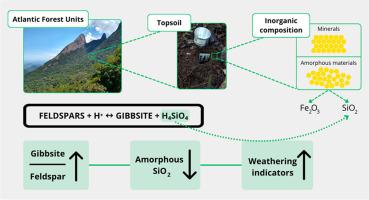巴西东南部大西洋森林热带山地表层土壤的无定形无机物质和矿物学
IF 1.5
4区 地球科学
Q3 GEOSCIENCES, MULTIDISCIPLINARY
引用次数: 0
摘要
无机无定形材料影响土壤的物理和化学性质,具有反映环境条件的潜力,有助于诸如养分循环、保水能力、碳捕获和稳定等过程。本研究旨在评价大西洋森林山区表层土壤中无定形无机物质的含量和组成以及粉质粘土组分的矿物学特征,并将这些属性与土壤风化指标联系起来。表层土样品采集于Serra dos Órgãos, RJ的两个站点(大陆坡- BM和海洋坡- SB)和Serra do Caparaó, ES (SM)的一个站点。用粉末x射线衍射(XRD)定量矿物学,用x射线荧光(XRF)测定总化学成分。采用内标法定量非晶态物质含量,通过质量平衡计算评估其组成。摩尔比表明钾长石和斜长石直接溶蚀,形成三长石为主要风化反应。无定形物质在所有表层土壤中占主导地位,在27%至44%之间,主要由SiO2 (100-230 g kg - 1)和Fe2O3 (30-70 g kg - 1)组成。对初生矿物和次生矿物的摩尔组成及非晶组分组成变化的分析表明,风化程度的变化趋势为:SM >; SB >; BM。无定形组分中SiO2的相对含量可以用长石分解成三长石的速率来解释,这是采样点风化过程的一个指标。本文章由计算机程序翻译,如有差异,请以英文原文为准。

Amorphous inorganic materials and mineralogy of tropical mountainous topsoils in the Atlantic Forest southeastern Brazil
Inorganic amorphous materials influence soil physical and chemical properties, with the potential to reflect the environmental conditions, contributing to processes such as nutrient cycling, water retention capacity, and carbon capture and stabilization. This study aimed to evaluate the content and composition of amorphous inorganic material and the mineralogy of the silt-clay fraction in mountainous topsoils of the Atlantic Forest, associating these attributes with indicators of soil weathering. Topsoil samples were collected from two sites in Serra dos Órgãos, RJ (continental slope - BM and oceanic slope - SB), and one site in Serra do Caparaó, ES (SM). Mineralogy was quantified using powder X-ray diffraction (XRD), while total chemical composition was determined by X-ray fluorescence (XRF). The amorphous material content was quantified using the internal standard method, and its composition was assessed through mass balance calculations. Molar ratios indicate the direct dissolution of K-feldspar and plagioclase, forming gibbsite as the main weathering reaction at all sites. Amorphous material constitutes the dominant fraction in all topsoils, ranging between 27 % and 44 %, composed mainly of forms of SiO2 (100–230 g kg−1) and Fe2O3 (30–70 g kg−1). Analyses of molar compositions between primary and secondary minerals and variations in the composition of the amorphous fraction revealed the following trend in weathering degree: SM > SB > BM. The relative SiO2 content in the amorphous fraction was explained by the rate of feldspar decomposition into gibbsite, which acts as an indicator of the weathering process at the sampling sites.
求助全文
通过发布文献求助,成功后即可免费获取论文全文。
去求助
来源期刊

Journal of South American Earth Sciences
地学-地球科学综合
CiteScore
3.70
自引率
22.20%
发文量
364
审稿时长
6-12 weeks
期刊介绍:
Papers must have a regional appeal and should present work of more than local significance. Research papers dealing with the regional geology of South American cratons and mobile belts, within the following research fields:
-Economic geology, metallogenesis and hydrocarbon genesis and reservoirs.
-Geophysics, geochemistry, volcanology, igneous and metamorphic petrology.
-Tectonics, neo- and seismotectonics and geodynamic modeling.
-Geomorphology, geological hazards, environmental geology, climate change in America and Antarctica, and soil research.
-Stratigraphy, sedimentology, structure and basin evolution.
-Paleontology, paleoecology, paleoclimatology and Quaternary geology.
New developments in already established regional projects and new initiatives dealing with the geology of the continent will be summarized and presented on a regular basis. Short notes, discussions, book reviews and conference and workshop reports will also be included when relevant.
 求助内容:
求助内容: 应助结果提醒方式:
应助结果提醒方式:


